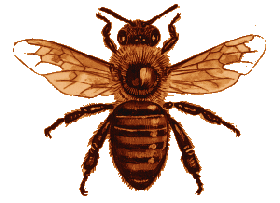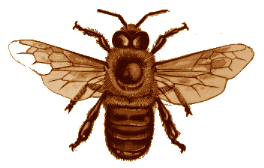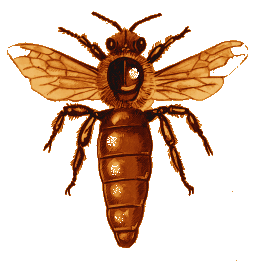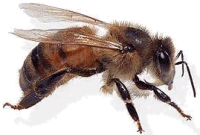WHO'S WHO IN THE BEEHIVE
Of the three types of honeybees found in a colony there are thousands of female workers, hundreds of male drones, and only one queen.
THE WORKER
All honeybees start life as an egg about the size of a comma "," which is laid by the queen in the bottom of a wax cell in the brood area of a colony. A worker egg hatches after 3 days into a larva. The bees feed it royal jelly at first, then pollen & honey for 6 days after which it becomes an inactive pupa.

During its 14 days sealed in a capped cell as a pupa it grows into a female worker bee. Workers do everything but lay eggs and mate. They build the comb from wax extruded from glands in their abdomen. The honey comb has hexagonal cells on both sides of a vertical central wall. These cells are inclined upward so that they retain liquid nectar and honey. The workers also clean, defend, & repair the colony. They gather nectar, pollen, water, and propolis and feed the larvae, the queen, and the drones. They ventilate, cool & heat the colony as necessary so that it functions efficiently.
WORKER BEHAVIOUR
Worker bees gather pollen which sticks to their back legs and is carried back to the colony where it is used as food. Pollen from the stamens of one flower sticks to their bodies, and is carried to another flower where it rubs off onto the pistil, resulting in cross-pollination. Mankind's food supply depends greatly on crop pollination by honeybees.
Nectar is sucked up by the worker bees through the proboscis, mixed with enzymes in the stomach, and carried back to the colony where it is stored in wax cells and evaporated into honey.
Worker bees also perform the "housekeeping" duties inside the colony. They work to maintain the brood chamber at 94 degrees F to incubate the eggs. If it is too hot, they collect water and deposit it around the colony, then fan air through with their wings causing cooling by evaporation. If it is too cold, they cluster together to generate body heat.
Propolis, a resinous substance excreted by certain plants, is used to seal any openings in the colony against draughts or invaders.
THE DRONE

Male bees are called drones. They emerge in 24 days and are larger than the female workers. They have large eyes and no sting. Drones lead a life of leisure, doing no work while being fed by the workers. Their sole purpose is to mate with a queen from any colony, thereby transferring the genetic traits of their mother. They either die as soon as they have mated or are expelled from the colony as winter approaches as they no longer have any function to perform.
THE QUEEN
Before an old queen dies or leaves to start another colony, she lays an egg in a large queen cell. The nurse bees feed the larva that hatches from this egg a diet of only royal jelly, or bee's milk, made from a gland on their heads. In only 16 days a new queen emerges and is cared for by the worker bees. She seeks out and destroys any rival queens as there can be only one queen per colony.

At 10 days old a new queen takes a high maiden flight, pursued by drones from nearby colonies.. Within a few minutes she mates with at least 7 of them, storing their sperm for the rest of her life. During the 2 years of her life the queen lays about 1200 eggs per day, about 200,000 per season. The number of worker bees needs to be replenished continually as they only live for 6 weeks in the summertime; and a colony needs to have 40 to 50,000 bees at its peak. The queen also produces chemical scents (pheromones) that regulate colony activity
